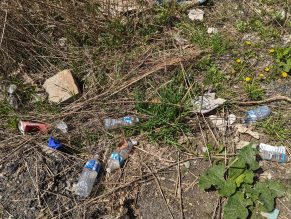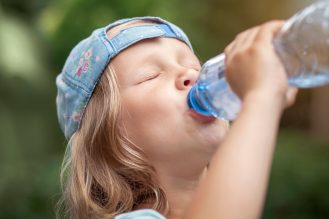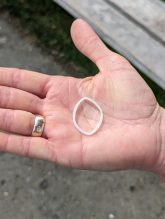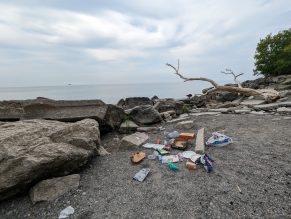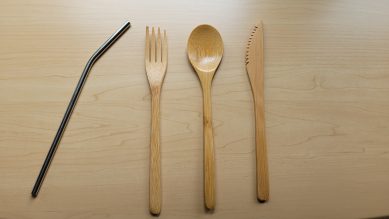The problem with single-use plastics
As plastics degrade, they get smaller, but don’t disappear. Plastic lasts a very long time.
Environment | June 25, 2024
Plastic can be found everywhere, especially single-use plastics.
Plastic water bottles, product packaging, bags and takeout containers are examples of everyday items that, despite their convenience, significantly contribute to waste and pollution. This not only affects our environment – but our health too.
The problem: single-use plastics
So why is plastic so popular? Simple – it’s inexpensive, easy to produce, durable and versatile. Plastic has been woven into our lives, from clothing to personal care packaging to food packaging. It’s used worldwide but has led to widespread environmental contamination. It’s production and distribution has a negative impact on the health of humans, animals, plants and waterways and contributes to an increase in greenhouse gas emissions and poor air quality.
While entirely eliminating plastics from our day-to-day lives may be difficult, the quality of plastic and reusability of it can make a difference. For example, purchasing plastic that does not contain Polyvinyl chloride (PVC) or Bisphenol-A (BPA) are more environmentally-friendly alternatives.
Plastic pollution is problematic because of the chemicals used, and greenhouse gas emissions generated during its production and disposal. In addition, many plastics can take anywhere from 100 to 1,000 years to break down. Much of this plastic ends up in landfills or as litter, harming humans, our environment and wildlife.
Eating, drinking and ingesting microplastics
You may not realize it, but you consume much more plastic than you think. Before you reach for a food or beverage product packaged in plastic – think twice. Recent research shows that plastics can enter our bloodstream, where they may end up in our bodies. That’s because the contents of these packages may contain microplastics and nanoplastics, extremely small particles, that can pass through your system. It can go straight to your bloodstream and collect in your tissues and organs. Chemicals associated with plastics can also leech into our drinking water.
Studies have found microplastics in our beverage and food sources – in meats that we consume, like pork, chicken, beef, turkey, fish and seafood. Plastics enter the food chain through animals ingesting them, ultimately affecting humans. These particles may cause cell damage, leading to severe health issues like cancer, lung disease and birth defects. Plastics also contain chemicals that can disrupt hormones and affect growth, reproduction and cognitive abilities.
This means that when we consume these food sources or products, we might also consume microplastics. Does this mean you should take up a plant-based diet? Well, not necessarily. Plants have also been showing signs of having microplastics in their roots from contaminated soil leading to people consuming plastics from them.
In 2022, Dutch researchers discovered microplastics in human blood for the first time, with particles found in nearly 80 per cent of participants. This indicates that these particles can circulate through the body and potentially build up in organs.
The complete long-term effects of microplastics on health are still unclear. Newer studies indicate there are risks, including lung cancer, metabolic diseases, nervous system damage, hormonal imbalances, obesity, insulin resistance and fertility issues.
Plastics on wildlife
Animals often mistake plastic waste for food, ingesting items such as plastic bags and bottle caps. This can block their digestive systems, leading to starvation, poor health and often death. Wildlife may eat items like water bottle caps, packing materials, food wrappers and other plastic items. In other cases, wildlife may get caught and entangled in discarded plastic materials, like fishing lines, plastic bags and packaging. This can lead to serious injury, infections, inability to move, starvation, drowning, suffocation and death.
As plastic decomposes, it releases toxic chemicals that endanger aquatic life and pollute water sources, including soil, creeks, rivers and lakes. Current data in the Journal of Great Lakes Research (2024) show extraordinarily high levels of microplastics near Toronto in Lake Ontario, with levels reaching 20 million particles per square kilometre.
The environment and plastics
Most plastic material produced ends up in landfills.
According to the International Institute for Sustainable Development, 86 per cent of plastic waste created in Canada goes to landfills. As it decomposes, it emits greenhouse gases — such as methane. In 2022, the global cost of plastic-related health effects was estimated at around $100 billion annually.
According to Statistics Canada, in 2019 an estimated 6.2 million tons of plastic was produced in Canada. Of this, around 2.3 million tons were produced for packaging, and about 970,811 tons were used in making vehicles. Of all the plastic produced, around 3.9 million tons ended up as waste, with packaging materials making up half of it. A significant portion, 95.7 per cent, of the discarded packaging was film plastic such as bags or plastic wrap, totalling 1.4 million tons.
In some cases, City crews are having issues with plastic pollution getting washed up on City beaches, littering parks, blocking stormwater drains from properly draining from streets, and plastic debris collecting in culverts and stormwater ponds.
Plastics in the Great Lakes
According to the Alliance for the Great Lakes, more than 22 million pounds of plastics pollution end up in the Great Lakes every year. Researchers have found high amounts of tiny plastic pieces in all five Great Lakes, which provide drinking water for 40 million people. They’ve found microplastics in Great Lakes fish, drinking water, bottled water and beer.
More than 500,000 pounds of litter has been collected in the past 20 years. About 85 per cent of this is plastic (or nine million pieces of litter). Much of the litter is from single-use items, which contain plastic, followed by cigarette butts, tiny foam pieces, plastic bottle caps and food wrappers.
As much as we want to avoid all plastic, there is a role in certain instances where plastic may be required, such as for medical products or in other instances where an alternative doesn’t exist.
The good news is that in many other instances we can reduce the consumption of plastics. During the month of July, the City of Mississauga is encouraging residents to limit and avoid using single-use plastics where possible. Residents are encouraged to reduce, reuse and recycle plastics with the overall goal of incorporating these everyday practices into their lives.
Limiting your plastic consumption
There is so much you can do to reduce single-use plastics and be a part of the solution to plastic pollution. Here are some easy ways to limit your plastic consumption:
- Carry reusable bags when shopping.
- Avoid buying items wrapped in plastic.
- Use a reusable beverage container instead of single-use containers. Try out a water bottle filling station available at all City of Mississauga community centres.
- Bring coffee or a hot drink from home in a reusable mug.
- Use a reusable cutlery set instead of disposable utensils.
- Choose to buy items with less plastic packaging.
- Pack lunches and snacks in reusable containers instead of one-time use plastic bags. Avoid storing or reheating food in plastic containers and opt for glass.
- Shop at bulk food stores to reduce packaging waste when possible.
- Cook at home instead of ordering takeout (takeout food often comes in single-use packaging).
- Switch to bar soaps instead of bottled shampoo and body washes.
- Repurpose old plastic containers and bottles.
- Recycle items properly.
- Participate in local city-wide litter clean-ups.
- Avoid littering. Throw your waste in the proper waste bins available throughout Mississauga.
Cutting down on plastic use and waste during Plastic-Free July
If you’re a business owner or vendor, consider joining the Plastic-Free July movement by reducing your reliance on plastic food containers, wraps, bags, cutlery and other plastic products to help prevent them from ending up in our landfills.
Reducing our daily plastic use is crucial, no matter where we are. Before opting for that plastic water bottle, consider how to adopt small measures to reduce plastic waste and prevent pollution. It is better for your health and the environment.
Check out some of the additional initiatives the City is doing to reduce plastic waste:
- Approved the Corporate Reduction of Single use Items and Guidebook
- Cleaning up debris in Lake Ontario with Seabins
- Fishing line receptacles
- Litter clean ups
Tags
Media contact
City of Mississauga Media Relations
media@mississauga.ca
905-615-3200, ext. 5232
TTY: 905-896-5151

